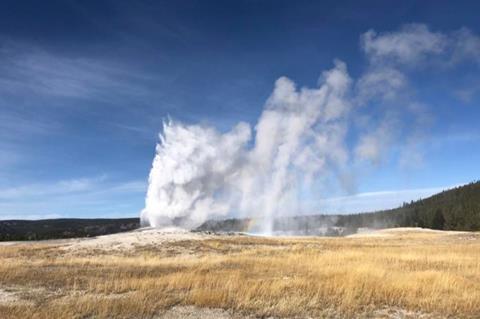Millions of tourists flock to Yellowstone National Park each year to see the eruption of Old Faithful Geyser. Hot water and steam are ejected in the air to a height of 100–180 feet approximately every 90 minutes.

New research by Lisa M. Keller, published on PNAS Nexus earlier this year and presented at the Geological Society of America’s GSA Connects 2023 meeting, shows that for some microbial life forms, Old Faithful Geyser is home.
PROMOTED: AMI has teamed up with QIAGEN to help you get the highest yields from your DNA Extractions. Get your free guide here.
Thermocrinis ruber is the most abundant bacterium residing in Old Faithful, making up over 60% of the microbial population. As a chemoautotroph, it makes its own energy, not only for its own sustenance, but also to the benefit of the rest of the microbial community.
Thermocrinis ruber takes CO2 outgassing from the geyser and turns it into carbon forms that are potentially cross-feeding heterotrophs in the community, such as Thermus aquaticus.
Thriving in adversity
Both bacteria are extremophiles - life forms that thrive where most would not survive. Geysers present a unique challenge: they are extremely dynamic environments. As if being thrown hundreds of feet in the air every 90 minutes isn’t disruptive enough, the microbes are subject to fluctuating steam and water temperatures that constantly change throughout the eruption cycle.
In every challenge there is an opportunity, and Old Faithful’s thermal excursions and eruptions are no exception. More strains of Thermocrinis are found in Old Faithful than in any other non-geysing hot spring in Yellowstone.
“We think that the highly dynamic geyser environment creates many different ecological niches that Thermocrinis can occupy, causing increased sub-species level diversity,” says Keller. These findings show not only that Old Faithful Geyser is habitable, but also that its dynamic environment promotes genomic diversity.
Collecting geysed water
In order to prevent any possible sample contamination, Keller collected geysed water as it was falling from the eruption in weighted sterile bins. Ten minutes after the end of the eruption she would walk out to the cone with a National Park Service escort and retrieve the precious samples. Additionally, she sampled a pool fed exclusively through Old Faithful’s eruptions.
Once back in the laboratory, Keller incubated the samples at different temperatures representative of geyser and pool conditions. The objective was to monitor the microbial activity to verify that the sampled bacteria would really be active at those extreme temperatures.
“They immediately showed signs of activity, suggesting there is active microbial life in Old Faithful waters!” says Keller.
Life beyond Earth
Beyond Earth, geysers are of extreme interest to the planetary community, as active geyser eruptions have been observed on the moons Enceladus and Europa.
“Everybody gets excited about sampling Enceladus plumes, but prior to this work we didn’t even have terrestrial geysers microbial samples,” Keller said.
”I thought, let’s take a step back and figure it out on our own planet first.”
Sampling planetary geysers may still be a long way off, as the current methodology requires filtering liters and liters of water - something that would certainly be challenging away from Earth - but now that we know for sure that terrestrial geysers can host life, the race to find it on planetary geysers is on too.







No comments yet